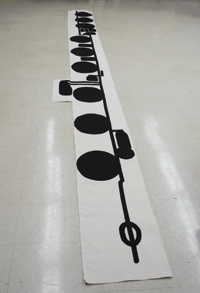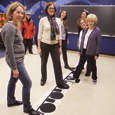Once summer lessons begin, both teachers and students have more flexibility in the use of lesson time. Preparation for honor and all-state bands is over as is the audition season. This can be an exciting time for exploring topics in a new way in private and in group lessons.
Flutists usually alternate in the way they approach fingerings. Once learned, they put them on autopilot until the day they notice there is a G sounding when they finger from an F to an A. At this point, a good flutist will zero in on which fingers move and which stay to achieve clarity in fingering. This alternation of being on autopilot and then intense scrutiny continues throughout the years as flutists become pickier about their playing.
For many years I constructed a fifteen-foot long flute diagram with duct tape on the floor of the rehearsal room or stage where I taught my summer flute masterclasses and group lessons. Fingerings were taught by having students stand on a key, lever or footjoint roller. As the name of the note was called, the students figured out if they were to step on or off the floor flute. At the end of the class, the duct tape was difficult to remove from the floor, so Victoria Jicha, Flute Talk editor emeritus, and I constructed a fabric Floor Flute. After the class, the Floor Flute is simply rolled up and placed in a bag – no more sticky residue left behind.
 Floor Flute
Floor Flute
A Floor Flute can be used with flutists of all ages. Eventually there will be nine flutists working on the Floor Flute, one for each finger needed to play the flute. For beginners you can begin with two or three students. To teach the first B have one flutist for the top key of the north stack, one for the thumb B or Bb, and one for the right hand pinkie D# key. If you have more than nine flutists in your class, one group can finger and play on their C flutes while the other group practices the fingerings on the diagram. Every few minutes the groups can switch places.
Exercises for Beginners
The first discussion should be about the placement of the left-hand thumb. If you teach the thumb Bb first, explain this placement in relationship to the B natural position. For those working on the C flutes, the left thumb should be straight and pointed towards the ceiling. The bottom of the thumb keys should touch the first joint back from the player’s nail. Having the key touch the thumb in this position prevents the left wrist from jutting or twisting out from a healthy position.
With the thumb in the B natural position, the keys, when closed in order, spell the word BAG. When lifted, they spell the word GAB. Have the students step onto the B key, then the A key, and finally the G key. There should be a person on the right pinky D# key for each of these three notes. The flutists will notice that the student standing on the D# key rarely moves. This encourages the realization that there are few notes that are played without the right-hand pinkie.
With a metronome set on 60, have the students step on to the Floor Flute mimicking the fingerings for B, A, G and then step off for G, A, B. Then randomly call each note name and see how quickly they can step onto the mat for the correct fingering. Have the flutists repeat this exercise on their C flutes using the metronome. As both exercises becomes easier, increase the metronome speed incrementally up to 120.
Once fluent in the B, A, G fingerings add the F and the E fingerings. All these fingerings have the right hand pinkie on the D# key. Practice going up and down the scale (E, F, G, A, B, C (thumb off) B, A, G, F, E) with the metronome. Practice trills from E to F by having the person on the E key lift and replace his foot as quickly as he can. Repeat the trills with F to G, G to A, A to B, and B to C. If you are an early music specialist, you can practice trills from C to B, B to A, A to G, G to F, and F to E.
Repeat this type of drill using one of the three-note melodies such as Hot Cross Buns or Mary Had a Little Lamb. After exploring this drill on the diagram, repeat on the C flute. For melodies, you may write them on a blackboard or white board or create a handout to encompass the material you wish to teach. Eventually students should be able to do the fingerings in rhythms.
Have students practice the lower and upper octave of E, F, G, A, B, and C. Quickly they will notice that the fingerings are the same for each of these notes in the first and the second octave. Use music note flash cards to practice this concept. Then teach the other three notes that fall into this same category (F#, G#, and Bb).
Intermediate Flutists
Use this method to explore major scales with intermediate-level flutists. First teach one-octave or nine-note scales before moving to two- and three-octave scales. Use a metronome to be sure the flutists step on and off the mat in time and with clarity of movement just as the fingers move on the flute. When a new fingering is introduced, have students practice trilling to and from the note.
Footjoint notes are often less understood than other notes. One by one have each flutist work on the mat to master the lowest D# (Eb), C#, C, and B. Be sure their feet are precise when standing on the roller keys. They can also work on minor, chromatic, and whole tone scales plus scales in thirds and arpeggios (major, minor, augmented and diminished).
To add articulation patterns into the mix, indicate slurred notes by holding hands and tongued notes by placing hands down at their sides. For vibrato practice, have each person wiggle 2, 3, or 4 pulsations (hula style) on each note of the scale (metronome set on 60). This exercise not only teaches subdivision, but that the vibrato should not stop when raising or lowering a key. The vibrato must be independent of the fingerings.
 Advanced Flutists
Advanced Flutists
Basically almost anything that can be played on the flute can be practiced on the Floor Flute. For advanced students practicing all trill fingerings, top octave notes (3rd and 4th octaves), sensitive or alternate fingerings, and fingerings that offer special challenges can make huge difference in flutists’ performance on their regular flutes. Many of the top octave fingering require both stepping on and off of the mat exactly in time.
The third octave F# to G# is one of the most difficult movements on the flute. Usually it takes several tries before flutists can execute this fingering eight times in a row on the Floor Flute without a mishap. Once they return to the C flute, there is a better understanding of what each finger does.
Bell Choir
The concept of this mat is similar to each person playing one or two notes in a bell choir. For this reason, with each exercise have students switch from one key to another so there is better understanding of the big picture.
Mental Imaging or Visualization
After working on the Floor Flute and on the C flute, have students practice difficult fingerings by visualizing which fingers move and which fingers stay without moving any fingers at all. Unlike most instruments, flutists cannot see their fingers while playing. Imprinting a movement plan in students’ minds improves the quality and timing of their movements on the flute.






